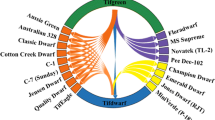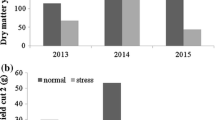Abstract
Hybrid bermudagrass (Cynodon dactylon (L.) Pers. × C. transvaalensis Burtt-Davy) is widely used for turf throughout subtropical and tropical climates because of its superior quality and performance. Development of cultivars adapted to broad range of environments is the main goal of many breeding programs. There is large variation for turfgrass characteristics and drought resistance among native bermudagrass (C. dactylon) germplasm originating from the Mediterranean region. Hence, the aim of this study was to develop triploid turf-type bermudagrass hybrids by making use of native genetic resources. Drought resistant tetraploid C. dactylon genotypes originating from the Mediterranean coastal region of Turkey were crossed with a diploid accession of C. transvaalensis from South Africa in 2011 and 2012. The hybrids were first identified using SRAP molecular markers. Then, phenotypic pre-selection was made for leaf shape, color and density and 273 hybrids were transplanted into the field. Two SSR markers further confirmed the true hybridity of 170 (62%) of these genotypes. Establishment rates in 2013, and turfgrass characteristics in 2014 and 2015 were recorded. Transgressive segregation was evident for estabilishment rate, turfgrass quality and color, and shoot density among progenies. Correlation analysis indicated that selection for shoot density, leaf texture, and prostrate growth habit could increase turf quality. The genotypes ‘45’ and ‘150’ were identified as promising parents for future breeding efforts as they provided positive general combining ability. The best ten hybrids with acceptable turfgrass characteristics were evaluated further under replicated field trials and line T4-C3 has just been released for commercial use.


Similar content being viewed by others
References
Beard JB (2002) Turf management for golf courses. Chelsea, Michigan
Bonos SA (2006) Heritability of dollar spot resistance in creeping bentgrass. Phytopathology 96:808–812
Burton GW (1947) Breeding bermudagrass for the southeastern United States. J Am Soc Agron 39:551–569
Burton GW (1960) Tifway bermudagrass. USGA J Turf Manag 7:28–30
Burton GW (1966) Tifway (Tifton 419) bermudagrass. Crop Sci 6:93–94
Burton GW, Hart RH (1967) Use of self-incompatibility to produce commercial seed-propagated F1 bermudagrass hybrids. Crop Sci 7:524–527
Carson PL (1980) Recommended potassium test: recommended chemical soil test procedures for the North Central Region. North Dakota Agric Exp Stn Bull 499:17–18
Croce P, De Luca A, Mocioni M, Volterrani M, Beard JB (2001) Warm-season turfgrass species and cultivar characterizations for a Mediterranean climate. Intl Turf Soc Res J 9:855–859
De Wet JMJ, Harlan JR (1971) South African species of Cynodon (Gramineae). J South Afr Bot 37:53–56
Doyle JJ, Doyle JL (1990) Isolation of plant DNA from fresh tissue. Focus 12:13–15
Griffing B (1956) Concept of general and specific combining ability in relation to diallel crossing systems. Aust J Biol Sci 9:463–493
Gulsen O, Sever Mutlu S, Mutlu N, Tuna M, Karagüzel O, Shearman RC, Riordan TP, Heng Moss TM (2009) Polyploidy creates higher diversity among Cynodon accessions as assessed by molecular markers. Theor Appl Genet 118:1309–1319
Guo Y, Wu YQ, Anderson JA, Moss JQ, Zhu L (2015) Disomic inheritance and segregation distortion of SSR markers in two populations of Cynodon dactylon (L.) Pers. var. dactylon. PLoS One. https://doi.org/10.1371/journal.pone.0136332
Guo Y, Wu Y, Moss JQ, Anderson JA, Zhu L (2017) Genetic variability for adaptive, morphological, and reproductive traits in selected cold-hardy germplasm of common bermudagrass. Crop Sci 57:82–88. https://doi.org/10.2135/cropsci2016.05.0369
Hanna WW, Schwartz BM (2016) Bermudagrass named ‘DT-1’. US Plant Patent, 392 P2. Date issued: 15 Nov
Hao Q, Liu ZA, Shu QY, Zhang R, De Rick J, Wang LS (2008) Studies on Paeonia cultivars and hybrids identification based on SRAP analysis. Hereditas 145:38–47
Harlan JR, De Wet JMJ (1969) Sources of variation in Cynodon dactylon (L). Pers Crop Sci 9:774–778
Harlan JR, De Wet JMJ, Rawal KM (1970a) Geographic distribution of the species of Cynodon L. C. Rich (Gramineae). East Afr Agric For J 36:220–226
Harlan JR, De Wet JMJ, Rawal KM (1970b) Origin and distribution of the seleucidus race of Cynodon dactylon (L.) pers. var. dactylon (Gramineae). Euphytica 19:465–469
Huang CQ, Liu GD, Bai CJ, Wang WQ, Tang J (2014) Application of SRAP markers in the identification of Stylosanthes guianensis hybrids. Mol Biol Rep 41:5923–5929. https://doi.org/10.1007/s11033-014-3467-0
Kenna MP, Taliaferro CM, Richardson WL (1983) Comparative fertility and seed yields of parental bermudagrass clones and their singlecross F1 and F2 populations. Crop Sci 23:1133–1135
Kimball JA, Isleib TG, Reynolds WC, Zuleta MC, Milla-Lewis SR (2016) Combining ability for winter survival and turf quality traits in St. Augustinegrass. HortScience 51:810–815
Koch MJ, Meyer WA, Bonos SA (2015) Inheritance of salinity tolerance in perennial ryegrass. Crop Sci 55:1834–1842
Li G, Quiros CF (2001) Sequence-related amplified polymorphism (SRAP) a new marker system based on a simple PCR reaction: its application to mapping and gene tagging in Brassica. Theor Appl Genet 103:455–461
Majidi MM, Mirlohi A, Amini F (2009) Genetic variation, heritability and correlations of agro-morphological traits in tall fescue (Festuca arundinacea Schreb.). Euphytica 167:323–331
NTEP (National Turfgrass Evaluation Program) (2006) 2002 National bermudagrass test. 2003–2006 Data. Final Report. NTEP No. 07–10. Available at. http://www.ntep.org/reports/bg02/bg02_07-10f/bg02_07-10f.htm. Accessed 5 Jan 2013
NTEP (National Turfgrass Evaluation Program) (2014): How is turfgrass quality evaluated? Available at. http://www.ntep.org. Accessed on May 15, 2014
Renvoize SA, Clayton WD (1992) Classification and evolution of the grasses. In: Chapman GP (ed) Grass evolution and domestication. Cambridge University Press, Cambridge, pp 390–395
Richardson WL, Taliaferro CM, Ahring RM (1978) Fertility of eight bermudagrass clones and open-pollinated progeny from them. Crop Sci 18:332–334
Saeidnia F, Majidi MM, Mirlohi A, Manafi M (2017) Productivity, persistence and traits related to drought tolerance in smooth bromegrass. Plant Breed 136:270–278. https://doi.org/10.1111/pbr.12466
Sas Institute (1999) SAS/STAT user’s guide. Release 8.0.SAS Ins. Cary, NC
Schwartz BM, Hanna WW, Baxter LL, Raymer PL, Waltz F, Kowalewski AR, Chandra A, Genovesi A, Wherley BG, Miller GL, Milla-Lewis SR, Reynolds WC, Wu Y, Martin DL, Moss JQ, Kenna MP, Unruh J, Kenworthy KE, Zhang J, Munoz PR (2018) ‘DT-1’, a Drought-tolerant triploid turf bermudagrass. HortScience horts 53(11):1711–1714
Sever Mutlu (2009) Collection, evaluation and molecular characterization of Cynodon dactlyon genotypes, and comparative evaluation with warm season turfgrass species under Mediterranean conditions, TUBITAK project TOVAG-105O586 (unpublished data)
Sever Mutlu S, Mutlu N, Selim C, Hocagil MM (2014) Broadening the genetic base of bermudagrass. Eur J Hort Sci 79(3):183–194
Severmutlu S, Mutlu N, Shearman RC, Gurbuz E, Gulsen O, Hocagil MM, Karagüzel O, Heng-Moss T, Riordan TP, Gaussoin RE (2011) Establishment and turf qualities of warm-season turfgrasses in the mediterranean region. HortTechnology 21:67–81
Sprague GF, Tatum LA (1942) General vs specific combining ability in single crosses of corn. J Am Oil Chem Soc 34:923–932
Taliaferro CM (2003) Bermudagrass (Cynodon (L.) Rich). In: Casler MD, Duncan RR (eds) Turfgrass biology, genetics, and breeding. Wiley, Hoboken, pp 235–256
Taliaferro CM, Martin DL, Anderson JA, Anderson MP (2006) Patriot turf bermudagrass. US Plant Patent PP16, 801
Tan C, Wu Y, Taliaferro CM, Anderson MP, Tauer C, Samuels T (2012) Development of simple sequence repeat markers for bermudagrass from its expressed sequence tag sequences and preexisting sorghum SSR markers. Mol Breed 29:23–30
Tan C, Wu Y, Taliaferro CM, Bell GE, Martin DL, Smith MW (2014a) Development and characterization of genomic SSR markers in Cynodon transvaalensis burtt-davy. Mol Genet Genom 289:523–531
Tan C, Wu Y, Taliaferro CM, Bell GE, Martin DL, Smith MW, Moss JQ (2014b) Selfing and outcrossing fertility in common bermudagrass under open-pollinating conditions examined by SSR markers. Crop Sci 54:1832–1837. https://doi.org/10.2135/cropsci2013.12.0816
Turchetto C, Segatto AL, Beduschi J, Bonatto SL, Freitas LB (2015) Genetic differentiation and hybrid identification using microsatellite markers in closely related wild species. AoB Plants 7:84. https://doi.org/10.1093/aobpla/plv084
Webster TM, Bednarz CW, Hanna WW (2003) Sensitivity of triploid hybrid bermudagrass cultivars and common bermudagrass to postemergence herbicides. Weed Technol 17:509–515
Weiler RL, Dall’Agnol M, Simioni C, Krycki KC, Pereira EA, Machado JM, da Motta EAM (2018) Intraspecific tetraploid hybrids of Paspalum notatum: agronomic evaluation of segregation progeny. Sci Agric 75(1):36–42
Wu YQ, Taliaferro CM, Bai GH, Martin DL, Anderson A, Anderson MP, Edwards RM (2006) Genetic analyses of Chinese Cynodon accessions by flow cytometry and AFLP markers. Crop Sci 46:917–926
Wu YQ, Taliaferro CM, Martin DL, Anderson JA, Anderson MP (2007) Genetic variability and relationships for adaptive, morphological, and biomass traits in Chinese bermudagrass accessions. Crop Sci 47:1985–1994. https://doi.org/10.2135/cropsci2007.01.0047
Ye S, Wang Y, Huang D, Li J, Gong Y, Xu L, Liu L (2013) Genetic purity testing of F1 hybrid seed with molecular markers in cabbage (Brassica oleracea var. capitata). Sci Hortic 155:92–96
Zeven AC (1979) Polyploidy and domestication: The origin and survival of polyploids in cytotype mixtures. In: Lewis WH (ed) Polyploidy, biological relevance. Plenum Press, New York, pp 385–408
Zhao X, Zhang J, Zhang Z, Wang Y, Xie W (2017) Hybrid identification and genetic variation of Elymus sibiricus hybrid populations using EST-SSR markers. Hereditas. 154:15. https://doi.org/10.1186/s41065-017-0053-1
Acknowledgements
This research was supported by the Akdeniz University under the project code Scientific Research Project: 2011.01.0104.009. The authors also would like to thank to Drs. Anne Frary and Muzaffer Karasulu for their critical review of the language of this manuscript.
Author information
Authors and Affiliations
Contributions
SSM conceived and supervised the study designed the methods and experiment. SSM, ST, MC and CS prepared plant materials and performed breeding, selections and field evaluation. NM performed molecular marker analysis. SSM and NM analyzed the data and drafted the manuscript. All authors read and approved the final version of manuscript.
Corresponding author
Ethics declarations
Conflict of interest
The authors declare that they have no conflict of interest.
Additional information
Publisher's Note
Springer Nature remains neutral with regard to jurisdictional claims in published maps and institutional affiliations.
Rights and permissions
About this article
Cite this article
Sever Mutlu, S., Mutlu, N., Tokgöz, S. et al. Development of vegetative triploid turf-type bermudagrass [Cynodon dactylon × C. transvaalensis (C. × mangennisii Hurcombe)]. Genet Resour Crop Evol 67, 177–189 (2020). https://doi.org/10.1007/s10722-019-00863-w
Received:
Accepted:
Published:
Issue Date:
DOI: https://doi.org/10.1007/s10722-019-00863-w




